Kurokawa Clan Castle
-Castle prepared for mountain pass of Suzuka Mountains-
Overview
Name: Kurokawa Clan castle (Kurokawashi-jo)
Alias:
Place: Tsuchiyama-cho Koka city, Shiga
Location: 34.95174840925735, 136.33851741477073
Type: Mountain Castle
Built: 16th century
Remaining remnants: Stone walls, clay walls and dry moats
Title:
Kurokawa Clan castle (黒川氏城) is located on the small hill at the meeting point of the main stream of Yasu-gawa river and its tributary Ugui-gawa river. Castle site exists western hoot of Suzuka Mountains, and at the middle of two mountainous roads which are Tokaido road (current Route 1) runs Suzuka-Toge pass and Yunoyama-Kaido road (current Route 477) passes Buhei-Toge pass.
Suzuka Mountains runs slightly curved over 60 kilometer at the border of Ise province (Mie prefecture) and Omi province (Shiga prefecture). The average height of the mountains is about 1,000 meter and not for suitable to pass, thus major roads run at north edge and south edge of mountains, which are Sekigahara area at north and Suzuka Toge pass at south.
But other than these major roads, there are several mountain road passes the mountains such as Kurakake-Toge pass, Ishigure-Toge pass or Buhei-Toge pass. These passes are too tough for modern cars then tunnels are used to penetrate mountains, but for old people who could accept narrow and steep slope it was a regular mountainous road.
Precise year is not clear but Kurokawa castle might be built by local lord Kurokawa clan in the middle of 16th century. In the medieval era, Koka area which is southeastern part of current Shiga prefecture was managed by alliance of small local lords. Among the cooperation and conflict of these small lords, Koka-school Ninja emerged as intelligence and command troop.
The group of these small local lords which belonged to Rokkaku clan, the governor of south half of Omi province, was formed by 53 families. Kurokawa clan was one of these 53 families, and might be at upper position. Their original territory was Kurokawa area at 3 kilometer south from castle site but they expanded their territory to Ayukawa area thus built Kurokawa clan castle as their new main base.
In the end of 15th century, Rokkaku clan who deprived manors of retainers of Muromachi Shogunate was attacked by direct expedition of Shogun. As Shogun gathered major governors, Rokkaku clan was far inferior and disposed their main base Kannonji castle (Shiga prefecture) and escaped into Koka area.
Facing Shogunate army, small lords of Koka area clan adopted guerrilla tactics utilizing its mountainous terrain. Rokkaku clan and Koka area roads resisted against Shogunate army over one year, and Shogun stayed military camp long time fell into ill and finally died. Shogunate gave up the expedition to Rokkaku clan and retreated, then Rokkaku clan could survive.
In the former half of 16th century, Rokkaku clan held its peak period under Sadayori Rokkaku (1495-1552). Under commerce promotion policy such as Rakuichi Rakuza (abolition of guild), Rokkaku clan economically prospered and intervened to the politics of Shogunate.
But after the death of Sadayori Rokkaku, there arouse the conflict between next leader Yoshikata Rokkaku (1521-1598) and major retainers. Azai clan of Odani castle (Shiga prefecture) once followed to Rokkaku clan left it and broke Rokkaku army at the battle of Norada in 1560. To cope with this situation Yoshikata propelled centralization but this arose further antipathy of retainers.
In 1563, due to the assassination of major retainer by Yoshikata, other retainers opposed to Yoshikata thus Yoshikata once left Kannonji castle. Finally Yoshikata returned to Kannonji castle under coordination, but the authority of Rokkaku clan significantly declined.
In 1568, Nobunaga Oda (1534-1582), the warlord of Owari province (western half of Aichi prefecture) who seized Mino province (Gifu prefecture) previous year, marched toward Kyoto city. As Rokkaku clan did not follow to Nobunaga, Nobunaga attacked front forts of Kannonji castle and fell them only in one day.
Yoshikata Rokkaku who thought impossibility to defend Kannonji castle left it and escaped to Koka area again. Yoshikata planned to make guerrilla battle against Oda army, but this time Rokkaku army already collapsed and major retainers such as Gamo clan changed to Nobunaga.
Even so Yoshikata Rokkaku kept his resistance against Nobunaga over five years. As a part of encirclement of Nobunaga Rokkaku army fought several times against Oda army, but Nobunaga broke his enemy one by one. Finally in 1573 Nobunaga made total attack to Koka area, and Yoshikata Rokkaku escaped to Koka area and finally retired.
Among this battle Kurokawa clan supported Rokkaku clan, but finally turned to Oda clan. Unlike Iga area where is at the next of Koka area but kept resistance against Nobunaga, Koka area wholly belonged to Nobunaga and offered their skill. Around this time Tokaido road did not run Suzuka-Toge pass, and there was no need to manage this area directly for Nobunaga.
In 1582, Nobunaga died in the incident of Honnoji, a coup d’etat by his general Mitsuhide Akechi (1528-1582). His general Hideyoshi Hashiba (1537-1598, later Hideyoshi Toyotomi) broke Mitsuhide at the battle of Yamazaki, and approached to next ruler, But there existed other important retainers of Oda clan, such as Katsuie Shibata (1521-1583) or Kazumasu Takigawa (1525-1586).
At that year there arouse conflict between Hideyoshi Hashiba who aimed at next ruler and other retainers of Nobunaga such as Katsuie Shibata or Kazumasu Takigawa. At this time Koka area was held by Kazumasu Takigawa, who originally held Nagashima castle (Mie prefecture) but seized north half of Ise province such as Kameyama castle or Seki castle (Mie prefecture).
In response to this, Hideyoshi sent large army to Kazumasu in winter, when Katsuie Shibata could not move by deep snow. At this time Omi province was mainly held by Hideyoshi, and the territory of Takigawa clan spreads at the opposite of Suzuka Mountains. Hideyoshi sent his main army from the north of Suzuka Mountain toward Nagashima castle.
At the same time, detached force of Hideyoshi captured Koka area from Kazuie, then attacked Kameyama castle across Suzuka Mountains. Kazumasu well resisted against overwhelming army of Hideyoshi, but after the fall of Katsuie Shibata at the battle of Shizugatake in next year finally surrendered to Hideyoshi. As a result, whole part of Ise province became the territory of Nobukatsu Oda (1558-1630), the second son of Nobunaga and allied with Hideyoshi at this time.
But in 1584, this time Nobukatsu broke with Hideyoshi and raised his army against Hideyoshi, in cooperation with Ieyasu Tokugawa (1543-1616). Suzuka Mountains became the front line between Hideyoshi and Nobukatsu, and Hideyoshi sent his main army from the north of Suzuka Mountains toward Komaki area of Owari province.
As inferior Nobukatsu and Ieyasu gathered their all army to Komaki area, Ise province stayed as second front line. But there was a risk of sudden attack by Nobukatsu to Koka area across Suzuka mountains, which could arise confusion at the backside of Hideyoshi and could lead to attack Kyoto city or Osaka city, where was the political and economic main base of Hideyoshi.
Prepare for the sudden attack across Suzuka Mountains, Hideyoshi reformed castles near Suzuka mountains and faces mountainous passes such as Toriihira castle, Tsuchiyama castle, Ueno castle or Kurokawa Clan castle. Contrary to ordinary small lord castle which only have one terrace, there castles are larger and have several terraces.
The central area of Kurokawa Clan castle is a rectangular shaped one of about 50 meter long and 30 meter wide, encircled by clay wall. This was originally built by a small castle of Kurokawa clan, but later stone walls are added to two gate at western and northern line, and south line which protected backward of the castle.
Surrounding central area, there remain several areas which are surrounded by the line of clay wall and dry moat. Outside of this line of dry moat, there are several terraces built on the ridge spreads toward west and south, and southwest slope between two ridges. These terraces do not have clay wall and might be used as camping place.
At the north of core areas, several large areas of 50 meter long and wholly encircled by clay wall stand at the both side of main road from front entrance. These large areas are used as the ground of residences of major retainers, and worked as front defense line in the siege,
Between two lines of terraces there was a main gate of the castle, which has the space of Masugata. Total size of the castle is about 500 meter long and 300 meter wide, and its size and structure is far above of the residence of small lord.
At the battle of Komaki Nagakute, Ieyasu Tokugawa tactically broke the army of Hideyoshi but could not reverse overall situation. Nobukatsu feared the loss of Ise province finally agreed with Hideyoshi by his arbitrary decision, and the battle between Hideyoshi and Ieyasu ceased.
Next year in 1585, looking at the stabilization of situation, Hideyoshi tried to manage Koka area as an entrance into Kinki region from Ise province. Most part of local lords of Koka area was expelled, and Kurokawa clan lost most part of their territories.
There was no necessary to keep large castle at this area, thus Kurokawa Clan Castle was abolished at this time. Finally Kurokawa clan survived as a small retainer of Edo Shogunate at this place, and there might be reform of the castle at this time.
Today no building remain but structure of the castle well remain on the hill. The depth of dry moat and steepness of the clay wall is overwhelming, and this shows the volume of construction injected to this castle. It can reach to two mountain passes only 30 minutes drive from castle site, and this fact clearly explains the reason why such strong castle was built at distant place and abolished just after the battle.
30 minutes drive from Shin-Tomei Expressway Koka-Tsuchiyama interchange.
Type: Mountain Castle
Built: 16th century
Remaining remnants: Stone walls, clay walls and dry moats
Title:
Brief History
Kurokawa Clan castle (黒川氏城) is located on the small hill at the meeting point of the main stream of Yasu-gawa river and its tributary Ugui-gawa river. Castle site exists western hoot of Suzuka Mountains, and at the middle of two mountainous roads which are Tokaido road (current Route 1) runs Suzuka-Toge pass and Yunoyama-Kaido road (current Route 477) passes Buhei-Toge pass.
Suzuka Mountains runs slightly curved over 60 kilometer at the border of Ise province (Mie prefecture) and Omi province (Shiga prefecture). The average height of the mountains is about 1,000 meter and not for suitable to pass, thus major roads run at north edge and south edge of mountains, which are Sekigahara area at north and Suzuka Toge pass at south.
But other than these major roads, there are several mountain road passes the mountains such as Kurakake-Toge pass, Ishigure-Toge pass or Buhei-Toge pass. These passes are too tough for modern cars then tunnels are used to penetrate mountains, but for old people who could accept narrow and steep slope it was a regular mountainous road.
Origin of Kurokawa clan
Precise year is not clear but Kurokawa castle might be built by local lord Kurokawa clan in the middle of 16th century. In the medieval era, Koka area which is southeastern part of current Shiga prefecture was managed by alliance of small local lords. Among the cooperation and conflict of these small lords, Koka-school Ninja emerged as intelligence and command troop.
The group of these small local lords which belonged to Rokkaku clan, the governor of south half of Omi province, was formed by 53 families. Kurokawa clan was one of these 53 families, and might be at upper position. Their original territory was Kurokawa area at 3 kilometer south from castle site but they expanded their territory to Ayukawa area thus built Kurokawa clan castle as their new main base.
In the end of 15th century, Rokkaku clan who deprived manors of retainers of Muromachi Shogunate was attacked by direct expedition of Shogun. As Shogun gathered major governors, Rokkaku clan was far inferior and disposed their main base Kannonji castle (Shiga prefecture) and escaped into Koka area.
Rise and fall of Rokkaku clan
Facing Shogunate army, small lords of Koka area clan adopted guerrilla tactics utilizing its mountainous terrain. Rokkaku clan and Koka area roads resisted against Shogunate army over one year, and Shogun stayed military camp long time fell into ill and finally died. Shogunate gave up the expedition to Rokkaku clan and retreated, then Rokkaku clan could survive.
In the former half of 16th century, Rokkaku clan held its peak period under Sadayori Rokkaku (1495-1552). Under commerce promotion policy such as Rakuichi Rakuza (abolition of guild), Rokkaku clan economically prospered and intervened to the politics of Shogunate.
But after the death of Sadayori Rokkaku, there arouse the conflict between next leader Yoshikata Rokkaku (1521-1598) and major retainers. Azai clan of Odani castle (Shiga prefecture) once followed to Rokkaku clan left it and broke Rokkaku army at the battle of Norada in 1560. To cope with this situation Yoshikata propelled centralization but this arose further antipathy of retainers.
Invasion of Nobunaga Oda
In 1563, due to the assassination of major retainer by Yoshikata, other retainers opposed to Yoshikata thus Yoshikata once left Kannonji castle. Finally Yoshikata returned to Kannonji castle under coordination, but the authority of Rokkaku clan significantly declined.
In 1568, Nobunaga Oda (1534-1582), the warlord of Owari province (western half of Aichi prefecture) who seized Mino province (Gifu prefecture) previous year, marched toward Kyoto city. As Rokkaku clan did not follow to Nobunaga, Nobunaga attacked front forts of Kannonji castle and fell them only in one day.
Yoshikata Rokkaku who thought impossibility to defend Kannonji castle left it and escaped to Koka area again. Yoshikata planned to make guerrilla battle against Oda army, but this time Rokkaku army already collapsed and major retainers such as Gamo clan changed to Nobunaga.
Becoming retainer of Nobunaga and loss
Even so Yoshikata Rokkaku kept his resistance against Nobunaga over five years. As a part of encirclement of Nobunaga Rokkaku army fought several times against Oda army, but Nobunaga broke his enemy one by one. Finally in 1573 Nobunaga made total attack to Koka area, and Yoshikata Rokkaku escaped to Koka area and finally retired.
Among this battle Kurokawa clan supported Rokkaku clan, but finally turned to Oda clan. Unlike Iga area where is at the next of Koka area but kept resistance against Nobunaga, Koka area wholly belonged to Nobunaga and offered their skill. Around this time Tokaido road did not run Suzuka-Toge pass, and there was no need to manage this area directly for Nobunaga.
In 1582, Nobunaga died in the incident of Honnoji, a coup d’etat by his general Mitsuhide Akechi (1528-1582). His general Hideyoshi Hashiba (1537-1598, later Hideyoshi Toyotomi) broke Mitsuhide at the battle of Yamazaki, and approached to next ruler, But there existed other important retainers of Oda clan, such as Katsuie Shibata (1521-1583) or Kazumasu Takigawa (1525-1586).
First conflict between both side of Suguka Mountains
At that year there arouse conflict between Hideyoshi Hashiba who aimed at next ruler and other retainers of Nobunaga such as Katsuie Shibata or Kazumasu Takigawa. At this time Koka area was held by Kazumasu Takigawa, who originally held Nagashima castle (Mie prefecture) but seized north half of Ise province such as Kameyama castle or Seki castle (Mie prefecture).
In response to this, Hideyoshi sent large army to Kazumasu in winter, when Katsuie Shibata could not move by deep snow. At this time Omi province was mainly held by Hideyoshi, and the territory of Takigawa clan spreads at the opposite of Suzuka Mountains. Hideyoshi sent his main army from the north of Suzuka Mountain toward Nagashima castle.
At the same time, detached force of Hideyoshi captured Koka area from Kazuie, then attacked Kameyama castle across Suzuka Mountains. Kazumasu well resisted against overwhelming army of Hideyoshi, but after the fall of Katsuie Shibata at the battle of Shizugatake in next year finally surrendered to Hideyoshi. As a result, whole part of Ise province became the territory of Nobukatsu Oda (1558-1630), the second son of Nobunaga and allied with Hideyoshi at this time.
Second conflict between both side of Suzuka Mountains
But in 1584, this time Nobukatsu broke with Hideyoshi and raised his army against Hideyoshi, in cooperation with Ieyasu Tokugawa (1543-1616). Suzuka Mountains became the front line between Hideyoshi and Nobukatsu, and Hideyoshi sent his main army from the north of Suzuka Mountains toward Komaki area of Owari province.
As inferior Nobukatsu and Ieyasu gathered their all army to Komaki area, Ise province stayed as second front line. But there was a risk of sudden attack by Nobukatsu to Koka area across Suzuka mountains, which could arise confusion at the backside of Hideyoshi and could lead to attack Kyoto city or Osaka city, where was the political and economic main base of Hideyoshi.
Prepare for the sudden attack across Suzuka Mountains, Hideyoshi reformed castles near Suzuka mountains and faces mountainous passes such as Toriihira castle, Tsuchiyama castle, Ueno castle or Kurokawa Clan castle. Contrary to ordinary small lord castle which only have one terrace, there castles are larger and have several terraces.
Structure of Kurokawa Clan castle
The central area of Kurokawa Clan castle is a rectangular shaped one of about 50 meter long and 30 meter wide, encircled by clay wall. This was originally built by a small castle of Kurokawa clan, but later stone walls are added to two gate at western and northern line, and south line which protected backward of the castle.
Surrounding central area, there remain several areas which are surrounded by the line of clay wall and dry moat. Outside of this line of dry moat, there are several terraces built on the ridge spreads toward west and south, and southwest slope between two ridges. These terraces do not have clay wall and might be used as camping place.
At the north of core areas, several large areas of 50 meter long and wholly encircled by clay wall stand at the both side of main road from front entrance. These large areas are used as the ground of residences of major retainers, and worked as front defense line in the siege,
Between two lines of terraces there was a main gate of the castle, which has the space of Masugata. Total size of the castle is about 500 meter long and 300 meter wide, and its size and structure is far above of the residence of small lord.
Afterward of castle
At the battle of Komaki Nagakute, Ieyasu Tokugawa tactically broke the army of Hideyoshi but could not reverse overall situation. Nobukatsu feared the loss of Ise province finally agreed with Hideyoshi by his arbitrary decision, and the battle between Hideyoshi and Ieyasu ceased.
Next year in 1585, looking at the stabilization of situation, Hideyoshi tried to manage Koka area as an entrance into Kinki region from Ise province. Most part of local lords of Koka area was expelled, and Kurokawa clan lost most part of their territories.
There was no necessary to keep large castle at this area, thus Kurokawa Clan Castle was abolished at this time. Finally Kurokawa clan survived as a small retainer of Edo Shogunate at this place, and there might be reform of the castle at this time.
Today no building remain but structure of the castle well remain on the hill. The depth of dry moat and steepness of the clay wall is overwhelming, and this shows the volume of construction injected to this castle. It can reach to two mountain passes only 30 minutes drive from castle site, and this fact clearly explains the reason why such strong castle was built at distant place and abolished just after the battle.
Access
30 minutes drive from Shin-Tomei Expressway Koka-Tsuchiyama interchange.


















































































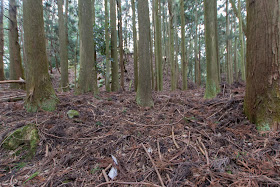











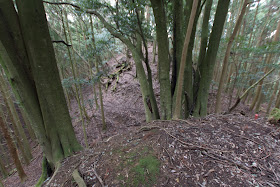





























































































































































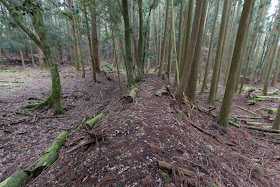


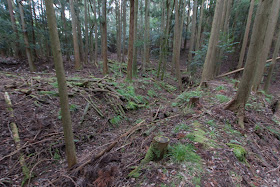




























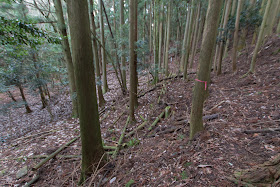

































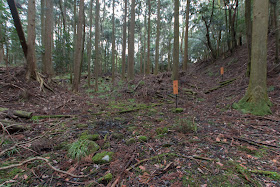






























































No comments:
Post a Comment